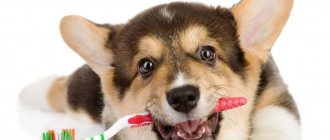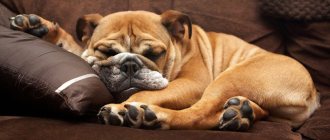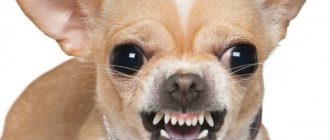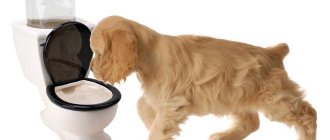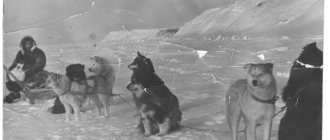Responsibility for the hygiene procedures of pets lies entirely on the shoulders of the owners. But not everyone knows how to carry them out properly and with what regularity. This article will tell you how to properly clean your dog's ears at home.
Read an important article on the topic: “What to do if your dog has ear pain: symptoms and treatment of otitis media.”
The need for ear cleaning in dogs
Sensitive hearing is very important for dogs, since through this organ they receive about a third of all information about the world around them.
Thanks to a developed sense organ, the animal can navigate the existing environment and take adequate actions in a timely manner. Due to the short stature of dogs and the habit of lowering their heads when running, sniffing the ground, as well as climbing through thickets, the ears quickly become clogged.
Dirt, moisture, and some types of insects get into both erect and drooping ears of pets, which mix with natural sulfur secretions and create an unfavorable environment that irritates the membranes of the ear canal.
Advanced cases of such pollution usually lead to the development of hearing problems in dogs, regardless of breed.
Ear cleaning time
Inexperienced owners find it difficult to decide how often to clean their dog's ears. In pets with erect ears, it is easier to notice accumulations of dirt.
- They need to have their ears examined every 2-3 weeks, depending on the time of year, as high humidity, swimming or walking in dusty areas can cause dirt to form more quickly.
- In dogs with floppy ears, the auditory organ is better protected from dust, but dries out more slowly from water and is poorly ventilated.
- For such breeds, the condition of the ear canals should be examined weekly and if there is visible accumulation of dirt, it should be removed, without waiting for an unpleasant odor and an inflammatory process to appear.
How is the procedure performed?
The procedure requires patience and consistent implementation of the following recommendations:
- Cleaning the ear canals is combined with combing the hair or bathing. It is advisable to clean your ears together. The short-eared dog is held, the long-eared dog is laid on its side, and the auricle is bent upward.
- They examine the ear and distract the pet with praise and gentle conversation. In case of severe contamination without signs of inflammation, apply cleaning liquid using a swab or stick. The shell is kneaded and massaged so that the solution is evenly distributed throughout the ear canal. To read the other ear, use a new swab.
- To remove fur from the shell, turn the bottle of powder over, point the tip into the ear canal, and press on the container. The fur falls out and is removed with fingers or tweezers.
Important! There is no need to scold your pet when he shakes his head: this is how the dog gets rid of excess cleaning fluid.
After the procedure, the pet is praised for good behavior and given a treat.
Accustoming pets to the procedure
Sometimes you can hear from a pet owner that the dog does not allow its ears to be cleaned. This behavior may mean that this procedure was previously associated with painful sensations or the dog was not accustomed to regular hygienic manipulations from puppyhood.
To make ear cleaning a habitual activity for a young animal, it should be taught gradually:
- First, you need to convince the puppy that the owner’s actions with his ears are safe, for which you sometimes call, stroke the head, massage the ear area and offer a treat.
- At the next stage, you can stroke the ears, lift them, look inside and again accompany the manipulation with encouragement.
- The first attempts at cleaning the ears should begin by wiping the upper part of the auricle with a soft cloth, without going deeper into the ear canal.
To ensure that the dog does not resist thorough and deep cleaning of the ears, the procedure should initially be associated with encouragement, and in no case should it be accompanied by roughness or pain.
Those who want to learn how to properly monitor their pet’s hygiene can familiarize themselves with the basic techniques in a video recording of cleaning a dog’s ears. If the process was initially started, then training an adult animal is also possible, but takes longer.
Maintaining a dachshund according to all rules
The exterior features of dachshunds are not only their highlight, it is a requirement for special conditions of detention and special care. To properly care for your dog with a long back and short legs, you will have to adhere to a number of rules. Dachshunds are prone to diseases of the spine, this imposes a special responsibility on the dog’s owners. You need to constantly ensure that your pet does not damage the intervertebral discs.
To prevent your dachshund from accidentally injuring his back, you will have to avoid stairs. If there are stairs in your home, do not allow your pet to go up and down them on their own. Always carry them carefully in your arms at home and in the entrance. To prevent yourself from going up or down, equip all stairs in the house with baby gates. If possible, you can equip the stairs with ramps for the safe movement of the dachshund around the house.
Similarly, you can equip all the home furniture that your dog likes to climb on with ramps. Special furniture ramps for animals are sold in pet stores. Jumping on and off furniture puts significant stress on the animal's back and can cause the development of serious back problems.
To properly keep a dachshund in an apartment, you should properly organize a place for the animal to rest. This should be a couch in a quiet place, protected from drafts, but away from heating devices. An old flannelette blanket covered with a cotton sheet is best. This bed can be easily washed when dirty.
Dachshunds are a breed that is not intended for street living. Even if you live in a warm climate, dogs should live in a house or apartment. The breed tolerates both heat and cold very poorly. In order for your pet to be healthy and live a long, happy life, it must be walked regularly, but kept at home. Leave the enclosures for other breeds!
What is needed to keep a dachshund in an apartment - a list of things
The owner must not only mentally prepare for the arrival of a new pet in the house, but also purchase the necessary accessories to ensure a comfortable life for the dog.
What is needed for a dachshund living in an apartment - list
- House for a dog. Dachshunds need a secluded place to rest. Dogs sometimes like to retire, taking a break from human society. A house made of natural materials with soft, removable bedding can be purchased at a pet supply store or made with your own hands from scrap materials (cardboard box or wooden box). In such a place the dachshund will feel protected.
- Two bowls. One bowl is needed for food, the second you will pour clean water into. It is best to choose models made of ceramics or stainless steel. They are easier to care for.
- Tray. Dachshunds are easily litter trained. For boys, you need to purchase a model with a column; for girls, a regular one will do.
- Absorbent disposable diapers. Some dogs of this breed are more willing to go to the toilet in a diaper.
- Wet wipes. Useful for cleaning the toilet and the place where the dog eats.
- Various toys. Special toys from the pet store will distract your pet from your shoes and upholstered furniture.
- Claw cutter. The nails of a dog living at home need trimming. It is best to do this carefully with a special nail clipper for animals.
- Collar. Textile models with a thickening in the center are suitable. Dachshunds feel most comfortable in this collar.
- Leash. The optimal leash length is 4-5 meters. This length allows the dog to calmly go about its business on the street and always be under the supervision of the owner. A harness is not suitable for this breed; it provokes the appearance of outward elbows, unevenly distributes the load on the dog’s body, and causes it to excessively stretch its neck.
- A brush with natural bristles or a massage mitten for caring for your pet’s coat.
- Treatment products for external and internal parasites . It is necessary to start the puppy's life in a new home with antiparasitic treatment.
- Veterinary shampoos . Hygiene products will come in handy. Dachshunds love to dig and can often get dirty.
- Cloth . You will need warm overalls for walking in the cold season and a raincoat for walking in the rain. Choose models made from natural materials that are comfortable and do not hinder the animal’s activity. Jumpsuits with a fastening at the back are best. Dogs of this breed are distinguished by a developed and mobile muscular system; they need walks at any time of the year and weather.
Important: to prevent your new pet from sharpening its teeth on furniture legs, corners of the apartment and your shoes, buy him special bones.
Disease Prevention
Regular ear exams and cleanings will not only help keep your dog healthy, but will also be a preventative measure throughout his life.
It should be borne in mind that natural sulfur secretions in puppies are observed in smaller quantities than in older pets. At the same time, older dogs are more susceptible to complications and diseases than young dogs.
Regular examination will help you pay attention to pathological changes in time, including: irritation with redness of the skin, hematomas, tumors of unknown origin, excessive release of sulfur and an unpleasant odor characteristic of inflammation.
Problems with ear health can be visually identified, as a dog experiencing pain walks with its head tilted to one side. In such cases, it is necessary to contact a veterinary clinic, because, without timely assistance, the pet may significantly lose hearing.
Professional ear care methods
The cleaning process itself is not much different mechanically, but a professional approach involves the use of certain preparations. The veterinarian can recommend a medicinal or hygiene product that can be purchased at a special pharmacy or any zoological supply store.
Among them, you can choose lotions and gels that are suitable for the age and breed of your pet, as well as the necessary cotton swabs and pads.
The procedure is always described in the instructions for the drugs and usually consists of the following sequence:
- Apply 2-3 drops of the product with a pipette into each ear, pulling it back a little;
- Gently massage the closed ears, distracting the dog from natural attempts to shake its head;
- After a couple of minutes, wipe the auditory organs with a disk or stick with cotton wool dipped in the same product.
At the same time, you should not immerse sticks with cotton wool too deeply into the auricle, so as not to damage the delicate eardrum, which differs little from the human one.
Pet owners sometimes doubt whether it is possible to clean their dog's ears with hydrogen peroxide.
- If there is visible irritation and itching, when the dog often scratches the area of the auditory organs, it is recommended to rinse the ears with a 3% solution of hydrogen peroxide.
- You need to drop no more than 5 drops of the solution into each ear, massage it gently, and then let your pet shake it off.
- You can finish the procedure by removing excess moisture with a dry cotton cloth.
How to properly clean a dog's ears and with what
To ensure proper and safe ear cleaning, you need to purchase the appropriate equipment:
- Bandage, cotton pads or balls;
- Children's ear cotton swabs;
- Ear cleaning liquid;
- Veterinary clamp (hemastatic).
Basic options for cleaning ears at home:
- Wrap a bandage around your finger, moisten it in ear cleaning liquid, wipe the inside of the auricle and as far as possible the ear canal. Or drop (the number of drops according to the instructions for the product, based on the weight of the animal) hygiene lotion into the ear, massage and let the dog shake out the liquid that has got into the ear canal, wipe the auricle with a napkin or bandage. When treating the ear canal with your finger, you need to be extremely careful not to hurt your pet.
- Soak a cotton ball or disk in ear cleaning liquid, squeeze out the excess, place it in the ear and massage a little. Remove the dirty cotton pad and wipe dry.
Dogs, as a rule, do not resist such manipulations, but the cleansing does not go deep enough.
Cleaning the ear canal, how to properly:
- Dip a baby cotton swab into hygiene lotion and squeeze out excess liquid with your hands. Very carefully, so as not to injure the pet, insert the stick into the ear canal (almost perpendicular to the horizon), rotate it around its axis and also carefully remove it. Repeat the manipulation, changing the stick, until the cotton wool becomes almost clean (sterile cleanliness in the ear is not required).
- Soak a piece of cotton wool or bandage in ear cleaning liquid, hold it in a veterinary hemastatic solution, and squeeze it out. Insert the clamp into the ear canal, rotate it around its axis, and carefully remove it. Change the bandage and repeat until it is clean.
Deep cleaning of a dog's ears at home is quite possible, even for small breeds, especially if you have a veterinary clip.
Some owners are afraid to clean the ear canal themselves, as there is an opinion that the eardrum can be damaged - this is a myth. A dog's ear canal is shaped like the letter "L" and it is impossible to damage it with a straight cotton swab.
Safety rules: do's and don'ts
Basic safety rules when cleaning your dog's ears:
- Breeds with a very narrow ear canal (Shar Pei) are not recommended to carry out deep cleaning on their own; it is better to contact a professional.
- Shampoos, soaps and other household chemicals, as well as vinegar or alcohol-containing substances, should not be used for the procedure.
- If the animal whines, shakes its head or constantly scratches its ears, most likely it is not a wax plug - you need to take the dog to the veterinarian.
- During manipulations, it is better for aggressive dogs to wear a muzzle or bandage their muzzle with a piece of bandage or tourniquet.
- Before you begin cleaning the ear canals, you need to train your dog to calmly respond to superficial cleaning of the ear.
- Carry out all manipulations as carefully as possible, without hurting the animal.
Also, it is not recommended to use ordinary cotton swabs, only for children, so that the cotton does not remain inside the ear canal (in children’s it is attached more tightly to the base). If an incident has already occurred, you should immediately contact a veterinary clinic for advice.
Is it possible to clean with hydrogen peroxide?
There are often articles on the Internet that if there are no special hygiene lotions, you can use hydrogen peroxide to clean your ears - this is not true. The dog’s ear should not be sterile; in addition, if there are any wounds or cuts, the pet will simply be in pain. After such a procedure, the dog will never allow the hygienic treatment to be carried out calmly again, as he will be afraid that he will be tortured again.
As a last resort, instead of a special lotion, you can use green tea. The leaves or bag are brewed until they are “drinkable”, cooled to room temperature, and without adding sugar they are used instead of a cleansing liquid. Green tea has light disinfecting and softening effects and is a worthy competitor to products from the pharmacy.
How to clean your ears with chlorhexidine
The scheme for cleansing the auricle and ear canal using chlorhexidine is identical to specialized means. There is only one “but” - chlorhexidine is diluted with water in a 1:1 ratio.
Cleansing with an undiluted antiseptic leads to overdrying of the skin of the auricle, subsequently leading to wounds, cracks, and painful sensations.
Special means
Veterinary pharmacies provide a wide range of drops, wipes, and ear cleaning solutions that are safe for animals. List of the most common products with prices:
- "Let's go for a walk." Hypoallergenic wipes for cleaning ears and eyes. Do not irritate the skin, soften irritation. A standard package of 80 pieces costs about 350 - 400 rubles.
- "Dewdrop". Solution for ears, has an antibacterial effect. Suitable for preliminary cleansing of contaminants when prescribing therapeutic ear drops. Price from 200 rubles for 30 ml.
- "8 in 1 Exel Ear Cleansing Liquid." Lotion for the delicate removal of dirt from the ear canal and ear. In veterinary pharmacies the average price is 300 rubles per 118 ml.
- "Stop the problem." It can be prescribed as a therapy to prevent the recurrence of otitis, reduces the risk of diseases of the ear canal and inflammation of the middle ear. Has a calming effect, reduces itching and inflammation. The price of a 50 ml package is from 150 rubles.
- "Leopard". Facilitates the cleansing procedure, quickly softens dirt, and has an antibacterial and disinfectant effect. The average price is 170 rubles for 20 ml.
- "Veda". Hygienic solution with chamomile, effective for cleansing and healing wounds, suitable for animals with sensitive skin. Has a softening and bactericidal effect. A 30 ml package will cost approximately 120 rubles.
- "Cliny." The lotion contains silver ions, due to which, in addition to cleansing, it has disinfecting and anti-inflammatory properties. Does not dry out the skin, but at the same time effectively copes with sulfur pollution. A 50 ml bottle costs about 210 rubles.
- "Cytoderm". Drops based on chlorhexidine and malic acid. They have an analgesic and bactericidal effect, relieve inflammation and irritation, and normalize the pH of the auditory canal. The drops cost around 250 rubles for 50 ml.
Use any of the listed drugs only according to the instructions on the package, preferably after consultation with a veterinarian.
Home Remedies for Ear Cleaning
When mild irritation or chronic diseases occur, folk remedies for caring for the hearing organs of animals are sometimes used. But owners need to know whether it is possible to clean a dog’s ears with herbal infusions and how to do it.
- Medicinal herbs include string, mint, celandine, chamomile or tea.
- In a strong herbal infusion for external use, moisten a cotton pad or swab, which is used to wipe the inner cavity of the ears 2-3 times.
- Aqueous solutions are never poured or instilled into the ears, since dogs very poorly tolerate any moisture entering this organ.
- Products such as ethyl alcohol, essential oils, vinegar, ammonia and soap solution can injure and burn the delicate skin of the auricle.
When caring for such a sensitive organ as a dog’s ears, you must follow the rules so as not to harm the pet.
How to properly care for a dachshund puppy
We are already talking about what needs to be prepared for the arrival of a new pet in the house, how to carry out the process of raising it. Now let’s take a closer look at the first days of a puppy’s life in a new home. Tips from dachshund owners will help you properly accept your new “family member.” And dachshund puppies are truly members of the family. Dogs that are always ready to be there and take part in all family matters.
First days in a new house - tips
In order to make the existence of a dachshund puppy in your home as comfortable and safe as possible, you must prepare yourself and prepare your home. You will have time for this, because a dachshund puppy lives with its mother dog for the first 1-2 months. You will have time to get to know him and learn from the breeder the character traits of the future pet.
Don't rush to adopt a puppy. Experts believe that the optimal age for weaning a puppy from its mother is 2-3 months. It is allowed to take dogs at the age of 45 days. But, if you are offered to buy a dachshund that is 1 month old, you should think about the integrity of the breeders. This is too early!
How to prepare the room for the arrival of a puppy:
- Remove all electrical wires that your pet can reach.
- Inspect house plants and get rid of dangerous and poisonous ones.
- Wash floors with disinfectants and put all outdoor shoes out of reach.
- If there are cats in the house, put their bowls in high places so that the puppy cannot accidentally eat from them.
- Have a conversation with the children, teach them how to properly handle a pet.
- Hide all household chemicals, detergents, and medications.
- Make sure all trash cans and baskets are securely closed and hidden from the dog.
- Check the yard for safety. Securely fence the area, bury a mesh around the perimeter of the yard so that the dachshund does not dig under it.
- Install ramps, dog gates, and, if necessary, bars on windows.
- Find the contacts of a good veterinarian so that he can immediately examine the dog and give his recommendations for the care and education of a dachshund puppy.
The main points that make up caring for a puppy are similar to caring for an adult dog. The significant difference is the frequency of feeding. Puppies eat more often than adult dogs and require a special diet.
Feeding frequency:
- 3 months and less – 6 times a day;
- over 3 months and up to a year – 3-4 times a day;
- from the age of 7-8 months they switch to two meals a day.
It’s good if the same person takes care of a dachshund puppy that appears in the house. This makes it easier for kids to get used to a new place.
Important: do not leave the puppy alone at home in the first days - this will help minimize stress and facilitate the adaptation process.


